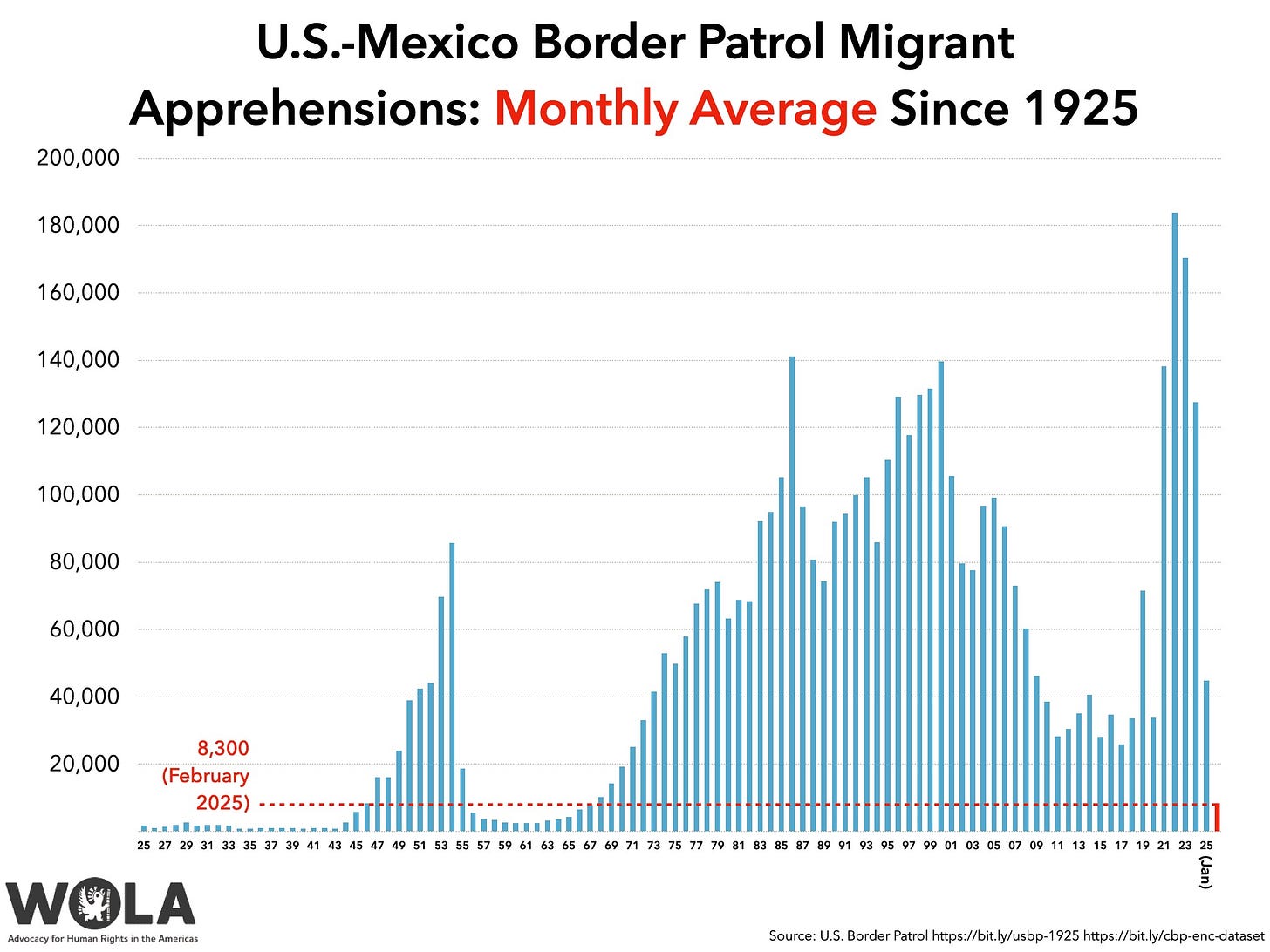Border Patrol Migrant Apprehensions Fall to Historic Lows
Cartel production & smuggling of Fentanyl also dropping
This week’s US Border Newsletter leads with some eye-opening human smuggling & drug seizure trends:
(Charts are from a recent report by WOLA.org).
February saw the fewest Border Patrol migrant apprehensions this century, and perhaps since the 1960s: Donald Trump revealed that Border Patrol apprehended 8,326 migrants along the border in February, which would be the fewest since at least 2000, the earliest year for which public data are available. Monthly averages were lower than that from the mid-1950s to the mid-1960s and during and before World War II. As occurred during the first months of Trump’s first term, migrants and smugglers are pausing their decisions to try to enter the country.
These latest reported numbers are in line with those we saw during the first Trump Administration:
Citing cross-border fentanyl trafficking, Trump again imposes and then withdraws tariffs on Mexico: President Trump followed up on a threat to impose 25 percent tariffs on all goods from Mexico and Canada. The main reason cited was the production and trafficking of fentanyl, which has been declining, though it seems apparent that the President’s disdain for trade agreements is a larger factor. Trump later lifted tariffs on most goods for another month.

Vance brings cabinet members to Eagle Pass: Vice President Vance went to the border with the Homeland Security and Defense secretaries (and met with Texas Governor Greg Abbott). His remarks focused mainly on organized crime in Mexico, not migration.

The U.S. military presence grows at the border: With the deployment of a Stryker brigade combat team and general support aviation battalion, the number of active-duty military personnel at the border will soon reach 9,000. The overall number of uniformed personnel could be over four times the number of monthly migrant apprehensions.
“Mass deportation” slows a bit, pending new money from Congress: Deportation flights increased modestly in February, and costly military flights have nearly halted since February 21. The Guantánamo Bay naval base is receiving fewer detainees amid cost concerns and interagency coordination issues. The White House is disappointed by its slow start, but a giant spending measure moving haltingly through Congress could remove its funding bottlenecks. Policy changes underway range from easing the firing of immigration judges to expanding expedited removal throughout the country to reopening family detention facilities.
Notes on the impact in Mexico and further south: Asylum applications are way up in Mexico even as migrant shelters empty. The numbers of migrants giving up and returning to South America have grown to the point that Costa Rica and Panama are now facilitating southbound transportation.
NOTE: This summary was generated from a far more comprehensive weekly summary by wola.org, which you can read HERE.
(If you found this summary helpful, we invite you to support WOLA’s work).
Finally, in case you missed it:

US Border News has reported concerning migrant smuggling trends at sea:

And - just in time for Easter - smugglers are taking advantage of high US egg prices by attempting to smuggle eggs from Mexico across the US border! :
We remain committed to delivering a US Border Newsletter that is not only educational and insightful but also engaging and easy to digest in five minutes or less
(How are we doing? Let us know in the comments!)
Abrazos y ¡Felices Pascuas! (Happy Easter),
Jack Beavers





